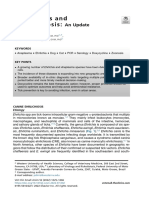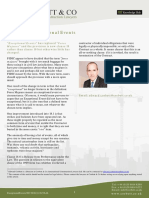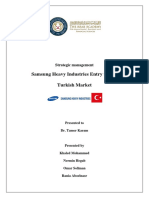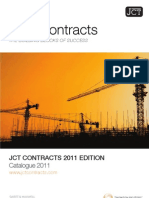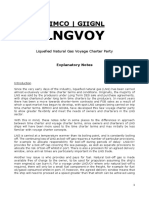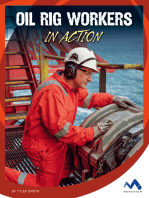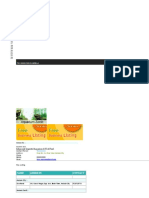Project Finance For Offshore Wind A Practitioner's View: EWEC 2010
Project Finance For Offshore Wind A Practitioner's View: EWEC 2010
Uploaded by
Joseph FrereCopyright:
Available Formats
Project Finance For Offshore Wind A Practitioner's View: EWEC 2010
Project Finance For Offshore Wind A Practitioner's View: EWEC 2010
Uploaded by
Joseph FrereOriginal Title
Copyright
Available Formats
Share this document
Did you find this document useful?
Is this content inappropriate?
Copyright:
Available Formats
Project Finance For Offshore Wind A Practitioner's View: EWEC 2010
Project Finance For Offshore Wind A Practitioner's View: EWEC 2010
Uploaded by
Joseph FrereCopyright:
Available Formats
EWEC 2010 Poster Session Topic: Project Finance and Private Equity ID No: PO 74
Project Finance for Offshore Wind A Practitioners View
Mr Christos Kolliatsas Mott MacDonald 1 Atlantic Quay Glasgow G2 8JB e: christos.kolliatsas@mottmac.com T: ++44 141 2229147 F: ++44 141 2229111 w: www.power.mottmac.com
Summary This paper draws from the experience as Lender's Technical Advisor for a number of offshore wind projects that have successfully achieved financial close. The author provides a practitioner's point of view on the mechanics of due diligence and the areas that are of key importance to lenders before financial close. The author also presents the key lessons learned from previous offshore projects as well as the challenges faced by future projects such as foundation designs due to deeper waters, wind turbine technology (bigger machines), electrical infrastructure (high voltage direct current substations), people, contracting, installations, vessels and operations (accessibility and maintenance strategies). The paper concludes that offshore wind has come a long way and will play an important role in the energy mix of countries that have that potential. However certain risks should be identified early and accounted for. The value of technical advisors cannot be underestimated as they can provide advice on key issues before shortcomings are discovered well into the construction of the project.
Project Finance for Offshore Wind A Practitioners View
1. Introduction Offshore wind has experienced a dramatic growth since its inception. The first semi-offshore wind farm was built on a harbour pier in Ebletoft, Denmark in 1986 with a total capacity of 880 kW. The next milestone was achieved in 1990 in Nogersund, Sweden, where the first near shore single turbine wind farm was constructed with an output of 220 kW. Vindey, Sweden hosted the first commercial near shore wind farm comprising of 11 Bonus 450 kW turbines. In 2002, Horns Rev became the largest truly offshore project (14-20 km offshore) with a total installed capacity of 160 MW. With such growth, it was only a matter of time before projects would seek financing and lenders would consider supporting them. In 2006, Q7 (now known as Prinses Amaliawindpark) achieved financial close and became the first offshore wind project world wide to be financed via a non-recourse loan. Consisting of 60 Vestas V80 2MW units, Q7 was at the time the furthest offshore (23 km) and in the deepest waters (24 m) wind farm. Commercial operations commenced in June 2008. Since then two further projects have received backing via project finance; Thornton Bank (now operational) and more recently Blighbank (under construction) both in Belgium. Future developments are even more ambitious. In the UK, Round 3 has resulted in 32 GWs of development rights. In Germany, 6.5 GWs are approved for construction in the Baltic and North Sea with an overall target of 38.5 GWs. Other countries are looking to tap into this resource including other European nations, China, Taiwan, Canada and the US. Drawing from experience gained by fulfilling the role of lead Lenders Technical Advisor, for all three (and only) project financed offshore wind farms to date, this paper provides an insight into how such projects are being assessed from a technical perspective by lenders and future challenges that face current and future offshore wind farms. 2. Non-recourse Finance This paper does not aim at providing an authoritative review of non-recourse finance, but instead this section provides a high level background to assist the reader in understanding lender concerns. Developers wishing to realise a project have a number of financing options which for major infrastructure projects, such as an offshore wind farm, are typically balance finance (equity) and project finance (debt). Balance finance relates to projects that are being funded by the developers equity without the support of any other financial vehicle. Since projects of this type are capital intense, balance finance is viable for major players such as utilities and oil&gas companies. Balance finance is achievable by using the developers own funds from any surpluses in its balance sheet (thus the name balance finance), therefore project risks are directly linked to the developer and thus any recourse will result in deterioration of its balance sheet. In order to mitigate some of this risk and to utilise the available capital for more projects, developers seek project financing with debt provision from lenders of typically 75% of the capital expenditure of the project (even though higher gearing ratios have been observed). To achieve that, developers set up Special Purpose Vehicles (SPVs) for which they hold 100% ownership. It is the SPV that would seek finance for the project, therefore the deal with the lenders will be with the SPV. For that reason, lenders will have limited to no recourse to the developer and thus the name non-recourse finance. It is evident from the above, that the lenders will actually carry the majority of project risk since their exposure far outweighs the exposure of the developer. The lenders therefore wish confirmation that the project will manage all risks be it contractual, legal, technical etc. In order to achieve this, a number of advisors are appointed to identify and quantify such risks, one of which is the Technical Advisor.
3. Technical Due Diligence 3.1 Overview One of the key documents that are required before Lenders can provide finance is a positive technical due diligence report. Positive technical due diligence report does not mean that the project will not face significant challenges. Instead the term relates to the risk profile and the measures put in place to mitigate major risks to such level that would be acceptable to the Lenders. 3.2 Project Participants It cannot be stressed enough how important people are, especially key personnel in the project team and key contractors after all these are the people who will make the project happen. Confidence in the various project participants such as the Sponsors, the project team, the key contractors, the offtaker, etc is key. Gaining confidence is a sophisticated process as opposed to a simple tick box exercise of looking at the participants background. Competence and past performance are important, however it is also important to understand the drive and motivations of key individuals, their ability to plan and cope with unforeseen situations and their willingness to cooperate and learn. At the end of the day, it is people who will deliver the project. 3.3 Project Design As part of the technical due diligence, project design is not the process of revalidation of each calculation. This is a duty that is undertaken by other players in the project. Technical due diligence on behalf of the Lenders focuses on the following main points: Is the contractor competent (follow on from the previous section)? Have reasonable investigations been undertaken? Does the design follow standard practice? Have the results been independently verified?
Confirmation of the above makes the process easier, however should there be deviations from the norm, it does not mean that the project is necessarily flawed. The industry is still evolving, therefore deviations are expected and need to be considered carefully. As part of the design review, the turbine technology and foundation design are key, especially taking into account that each project is likely to include worlds first components until the offshore industry reaches a certain degree of maturity. 3.4 Contracts Depending on the project, there could be one or many contacts. Having a fully wrapped Engineering, Procurement and Construction (EPC) contract is seen very favourably by the lending community, however this is not the norm currently. This situation has not prevented projects reaching financial close as Prinses Amaliawindpark, Thornton Bank and Bligh Bank have illustrated. Typically, there will be a Turbine Supply Agreement (TSA) and a Balance of Plant (BOP) contract for the construction of the project. The BOP can be broken down to a number of contracts covering vessel supply, electrical infrastructure, cables, foundations etc. The contractual complexity has advantages and disadvantages: more contracts should mean lower price but require bigger, more knowledgeable project team with hands on involvement and have a higher risk profile due to amongst others the interface risk.
Further contracts include Grid Connection Agreement (GSA) with the grid network, Power Purchase Agreement (PPA) with the offtaker, Services and Availability Agreement (SAA) typically with the turbine supplier covering availability and performance guaranties. Each of these contracts needs to be reviewed to establish that the scope of the project is wrapped and that no material gaps are present. Construction and operational risks should be mitigated as much as possible either by designing them out, passing them to contractors (for a premium), insuring them and managing them. Typically some of the risks related to contracts and wind farm design will be further mitigated by contingencies. 3.5 Energy Yield Further to the above, a review of the energy yield studies is typically required to confirm the assumptions in the financial model. As with the design, the energy yield review does not require a full remodelling. Instead, confirmation is required that: the selected software is appropriate; the data quality is acceptable; and the data sources are representative and reliable.
Once the above have been confirmed, an uncertainty analysis is carried out to validate or propose P75, P90 or other statistical figures. 3.6 Completion and Operational Risks Following the review of the above subjects, the completion and operational risks will be clearly identified and mitigation measures either confirmed or proposed. Detailed analysis of the proposed vessels and their operational envelops are fundamental in understanding whether the schedule is achievable. Also the met ocean data (wind, wave, current, swell) is used to establish achievable accessibility numbers and translate these to availability figures for the operational phase of the project. 3.7 Environmental and Permitting A high level review of permits is usually required from the technical advisor as support to the legal counsels work. Furthermore, the environmental performance of the project will be judged against international standards such as the Equator Principles. Non conformance with the Equator Principle is a key risk to the project as the majority of multilaterals and multinational banks will not finance such project. Environmental risks will be identified and potential mitigation measures verified or proposed. 3.8 Financial Model The technical advisor will typically review the technical assumptions of the financial model such as capital expenditure (capex), operational expenditure (opex), energy yield, timing of construction costs, major reserve accounts (MRA), liquidated damaged (LDs) and contingencies. The aim here is to review and confirm that the numbers are reasonable, in line with market conditions and provide comfort to the Lenders that sufficient funds are available to complete the project. 4. Challenges 4.1 Overview The latest installed rated power for each turbine now stands at 5 MW with 6 MW units expected for the next round of projects and 10 MW units not that far off in the near future. Such rapid expansion has resulted in a number of projects being prototypes, either by using new units, new foundations, new installation concepts, going further offshore etc. Dealing
with these types of projects poses some issues. Based on the work done to date, key challenges for the industry are: Construction; Installation; People; Contracting Strategies; and Operations.
The following are also key issues/challenges that should be given due consideration but are outside the scope of this paper: Planning. Depending on the country, planning and consent can be cumbersome resulting in delays and expenses. Some governments and local authorities have tried to streamline the process, however developers should be aware of the potential issues. Issues have also arisen in the past with permits being too descriptive about the project so again developers should consider the stage and certainty of design before committing to a permit. Tariff. So far a number of support mechanisms have been drawn up to make these projects viable. Such mechanisms have ranged from advantageous tariffs to green certificates and tax benefits. Issues have arisen when such support mechanisms have come to an end as well as criticism for the amount of subsidy available. The industry should move to cheaper solutions so the impact of such mechanisms is not as critical to projects. Supply chain. The industry is currently facing a shortage of people with the relevant knowledge and experience. Appropriate actions should be taken to address this issue from a number of stakeholders including governments, educational institutions and the industry before this becomes a long term problem and bottleneck for further development. Furthermore, heavy lift vessels are proving to be an issue, even though suppliers have identified the potential and are now investing in new vessels. Nevertheless, it is not clear yet if the vessel suppliers will catch up or if there will always be a shortage of vessels. Control of the vessels is also likely to become significant in terms of contracting strategies. Finally, ports and harbours are likely to be the next bottleneck as the requirements for these projects will exclude a number of harbours. Securing an onshore base close to the project with the right specification and facilities could be tricky in the future.
4.2 Construction 4.2.1 Foundations (Monopile, GBF, tripods/jackets, floating) Monopiles have been the foundation of choice so far in the offshore industry primarily due to the relative shallow waters. However, as development is moving to deeper waters, using monopiles is not always technically possible. As a result, gravity based foundations (GBFs), tripods and jackets have been utilised in some projects to account for such issues. Nevertheless, even with these alterative designs, it is not possible to venture into very deep waters. In that area, floating foundations are seen as the solution. Used for some time now in the oil & gas industry, this is a proven technique for installing platforms, however this design needed some alterations to be usable for the particular geometry and loading of an offshore wind turbine. Conventional foundation design (such as monopiles) is not seen as a major risk, however in an effort to reduce costs, developers have started to opt for bespoke designs for each turbine location. Such strategy could ultimately result in reduction of costs up to 15%, however the quality control and project management need to be extremely stringent to minimise the risk of installing the wrong foundation at the wrong location. Logistically during the construction period, such strategy could introduce problems as often due to the offshore environment the installation sequence is altered. Trying to load onboard from the harbour the correct monopile might not be an easy operation.
There have been issues with the manufacturing quality of monopiles further reinforcing the requirement for good quality control in all stages of the project. GBFs have not been immune to problems either. Manufacturing of foundations could also affect the project schedule and logistics. Monopile foundations are considered to have the shortest lead times, whereas GBFs need to be constructed close to the harbour for ease of transportation. Jacket foundations require some five months delivery time for each one, however improvements in manufacturing should be expected as the demand increases. 4.2.2 WTG technology As discussed earlier, turbine technology has progressed at an incredible pace. By the time a state-of-the-art at the development stage project begins installation, a number of bigger and more advanced turbine models have been developed. This situation is likely to come to equilibrium, however at this stage it is not clear which capacity will prove to be ideal for offshore wind. Such evolutionary (and sometime revolutionary) design changes make a number of projects prototypes but developers are happy to trade off the risk of a new design for the promise of better returns. Choosing the winner in terms of design features is not a foregone conclusion. Some designers have proposed going back to designs that were not seen as suitable for onshore wind (some due to appearance) like one and two blades machines, lattice towers, etc. Others are considering horizontal as opposed to vertical turbines. Finally, more and more suppliers are looking at light weight direct drive (no gearbox) which may prove to be the way forward but it is still too early to say. Regardless of the model and design, due to the infant nature of these units, quantifying the technology risk can be difficult. Certification certainly provides extra comfort, however it would be foolish to rely only on this mitigant. Developers and suppliers should aim to share the risk; a suggestion being supporting the TSA with strong 5 year or longer Operations and Maintenance (O&M) agreement with improved contract conditions. Another way of sharing the technology risk may be for developers to use prototype machines for their projects in exchange for some degree of testing from the supplier (supplemented by a significant reduction in the price), something that is quite normal in other power generation technologies. Even for more established models, availability figures and failure rates are notoriously difficult to obtain. In any case, the suppliers need to facilitate the development of the industry by taking a reasonable amount of technology risk. Turbines have long lead times and recently have been the primary bottleneck in the offshore wind industry. Following the credit crunch, lead times have reduced but not significantly. In any case, developers should assess the manufacturing capability of the suppliers and establish the suppliers forwarding book in order to better account for supply durations in the project schedule, but it is noted that in the current sellers market this may be difficult. 4.2.3 Electrical Infrastructure Electrical design as with other aspects of offshore projects has been varied. In some occasions export to an onshore substation has been through the closest to shore turbine whereas in other cases an offshore substation has been required. Levels of redundancy tend to be low, with typically a single point of export and a single export cable connecting onshore. Some projects have considered more export cables for electrical redundancy however close spacing of these cables do not minimise the risk of accidental damage of all export cables for example by an anchor. Separate substations have also been considered depending on the number and geographical spread of the wind farm. Typically, the interarray cables are connected in a radial arrangement even though some projects have considered rings (loops). Radial connection is cheaper due to the size of cables used but if there is a problem with the cable at the first turbine in the string, then the whole string cannot export electricity.
In all cases, a cost benefit analysis is required to determine the optimal electrical design considerations as the extra costs may outweigh the benefits of the extra redundancy. Regarding the transmission technology, as these projects move further offshore, DC transmission is becoming more prominent as transmission losses are minor compared to AC. The technology is proven for land to land and subsea cables with single point of entry designs. For offshore projects, where a number of cables are likely to terminate in the substation, issues with multi-entry and sea to land connections should be considered during the design and equipment selection process. Special consideration should also be given for the actual offshore infrastructure as these are substantial structures especially compared to traditional HVAC substations. 4.3 Installation Apart from all the risks related to design and manufacturing of the major components, the key risk for offshore wind projects relates to the actual installation. Ultimately there are two key issues which are not completely unrelated: metocean conditions and installation vessel. Metocean conditions (including wind, wave, tide, swell) can be predicted to a reasonable degree. The quality of prediction depends to a large extent on the quality of data collected and the prediction methodologies. Good quality, close proximity, long term data are fundamental ingredients. A conservative approach should be considered in order to allow sufficient time for completion as well as vessel selection. In any case though, the weather will be what it will be, therefore, contingency should be considered in terms of both time and budget to account for worse than expected weather. The expected metocean conditions should be considered when deciding on a vessel. Projects have encountered problems by using what was available at the time as opposed to what was appropriate. Ultimately, you need the right tool for the job. The operational envelop of the vessel should compliment the expected metocean conditions and the schedule assumptions. Close to shore in relative shallow waters projects have been successfully constructed using barges with stabilising legs however as the projects have moved further offshore, jack-ups have become a necessity especially for turbine installation, by providing a stable platform. Nevertheless, jack-ups also have a depth limit, so far-offshore projects will need floating foundations and other methods of deployment. Provided that the correct vessel was used, installation of the major components has not proved to be a major issue. That cannot be said for cable installation which has proved more troublesome. Issues with the liquidity of cable contractors, blocked j-tubes, achieving the right burial depth and ultimately duration of installation have been experienced by the vast majority of the projects. Complex, sophisticated procedures have not resulted so far in the desired results. Reasons may have to do with the lack of experience in the industry in general and some improvement should be expected in the future. Simple methodologies appear so far to work better. 4.4 Participant Capabilities It cannot be stressed enough how important people are. Successful projects have had competent and experienced project management teams. The importance of the team is crucial as the difference between a successful and a less successful project is usually fine. Therefore confidence should be gained that the team that will implement the project is of top quality. Projects have utilised experienced onshore wind project teams with limited success. Compared to onshore projects, offshore wind is significantly more complex with unique issues and onshore experience loses its relevance. Contactors also need to show substantial competence. Experience in other offshore areas is not necessarily a guarantee for good performance in offshore wind. While it is a good starting point to have a reputable contractor, it is also important the contractors team to show willingness to learn and adapt to the requirements of the project as these will unfold during
construction. Contractually, clauses could be utilised to incentivise the contractor, however this is not always a winning strategy and an environment of co-operation has so far produced the best results. 4.5 Contracting Strategies Early projects were constructed under single turnkey EPC contracts. Due to the nature of the projects, the reward for taking all the construction risk did not materialise and as a result contractors lost significant amounts of money. Lessons were learned and a shift has occurred leading to the current situation of multi-contract strategies. The market also changed and the current sellers market enables contractors (especially turbine suppliers) to pass a number of risks to the owners. The shift has now reached the point where projects enter TSAs that only cover supply and commissioning of the turbines (but no erection) with all other aspects being wrapped up by a balance of plant (BOP) contract or number of individual packages. Currently, number of contracts per projects range from two (TSA and wrap up with a BOP contract) to upwards of ten (TSA, vessels, substation, cables, foundations, etc). The contracting strategy is driven by two separate perspectives: the contractors willingness to accept specific levels of risk and the developers aim of reducing the capital expenditure (capex). More contracts typically mean lower prices as project management and the risk of brining the project together lies firmly with the developer. It should be noted however that the developer will incur higher costs in terms of project management as it will require a more substantial team to realise such project. The reduction of the cost of contractors however far outweighs such expenditure. No one has recently constructed an offshore wind project under a fully wrapped EPC contract, however the EPC wrap-up is likely to be in the region of 2030% of the construction capex. Turnkey EPC contracts are preferable to financiers as it is easier to understand where the risks rest and in case of problems with the project easier to understand where the finger should be pointed at. However, financiers have become more comfortable with the current multi-contract situation. Developers need to show a very good understanding of the interface issues as well as a strong project management team. Further contingency should be provided in terms of float in the schedule and available money. It is not unreasonable to expect the financiers to require a contingency fund of close to the EPC wrap up price for projects with a large number of contract packages. The upshot to the developer is that if the project is managed well, such contingency fund will not be utilised and instead it will be released back to the investors. It is difficult at this stage to gage how the contracting will evolve in the future but multicontracting is likely to continue for the foreseeable future. Nevertheless, major engineering companies may start considering offering EPC services. Potential downturn in other engineering areas (traditional power generation, oil & gas, process engineering) may accelerate the process and result in EPC services being provided from such firms due to necessity as opposed to opportunitism. 4.6 Operational For offshore wind, availability equals money as the current dispatch regime enables wind projects to export electricity when it is produced. It is therefore imperative that availability is kept as high as possible. Turbine availability will be affected by a number of parameters primarily the reliability of the turbines and accessibility. Reliability of the turbines is something that the owner can affect by choosing the correct turbine for the conditions and supplementing it with condition monitoring systems, etc. Due consideration should therefore be given with regards to the wind regime and how well the turbine model will suit it, operational history of the particular unit, etc. However, past history does not necessarily mean that the owner will not end up with a bad unit. Certification is a mitigant but the owner should have an active presence during the manufacturing of the
turbines and testing of the various components. Contractually the TSA should be supplemented by a strong long term O&M contract with high availability guarantees. Regarding accessibility, similarly to the construction phase, the metocean regime should be considered when selecting the number and type of transfer vessels in order to achieve the availability assumptions. The effort should be to achieve as high as availability as possible during favourable weather periods and minimise downtime during onerous weather conditions. It should be noted that helicopter transfers have been considered but not implemented widespread as the projects are still not far offshore and the effect on availability does not appear to be significant for the associated cost. However, as projects start being built further offshore, traditional access methods are unlikely to be viable and already projects are considering offshore accommodation either as hotel vessels or permanent structures. Transfers to these bases are likely to be by helicopters similarly to oil & gas structures, and maintenance vessels will be docked or launched from such structures when required. Major interventions are interventions that will require the use of heavy lift vessels such as jack-ups for operations such as the replacement of gearboxes. Unscheduled major interventions could be costly in terms of revenue lost and cost of repairs. Some mitigation is possible with condition monitoring systems although it is expected that more sophisticated systems will be developed over the next decade that can identify major issues early and thus enable the operator to plan for such intervention during favourable conditions in terms of weather and cost. Availability of suitable vessels is likely to still be an issue for scheduled major interventions but not as significant as during construction. Owners and financiers place great emphasis on the turbine performance and availability. However the biggest operational risk for an offshore wind farm is the availability of the single point of failures, basically any structure and component associated with the export of electricity. Such failure, depending on the design of the project, could result in no electricity being exported from the whole wind farm for a prolonged period of time. Therefore consideration should be given on spare parts and accessibility of the offshore substation. Projects are considering and implementing helicopter transfers to offshore substations as it is beneficial from a cost benefit point of view to have the substation operational as soon as possible. Furthermore, helicopter transfers to such structures tend to be less onerous than to turbines.
5. Conclusions
Offshore wind is and will continue to play an important role in the energy mix of many countries that have the resource and will to harness it. It is important to note that there are not many new lessons to be learned in offshore wind but old ones have to be revisited. A number of risks, some of which are unique to this industry, should be fully understood before embarking on such projects as these risks affect the design, manufacture, installation and operation of the offshore wind farm. Mitigation measures and management of these risks are fundamental to the success of these projects. Developers should consider these risks and come up with a strategy that would minimise them. Equally, potential investors or financiers should aim to understand and quantify these risks before deciding to proceed with the deal. A technical advisor that has a very good understanding of these risks and a track record of leading projects to financial close will provide substantial value to the decision making and assessment of the risk profile of offshore wind projects and could facilitate selecting the front runners from the dead horses.
You might also like
- A Very Potter Sequel ScriptDocument106 pagesA Very Potter Sequel ScriptNerdypup100No ratings yet
- Services Onshore and Offshore Edition 4 2019 UNLOCKEDDocument52 pagesServices Onshore and Offshore Edition 4 2019 UNLOCKEDef BrodNo ratings yet
- Karpowership Introduction PresentationDocument26 pagesKarpowership Introduction Presentationarryman.adhia100% (1)
- Michael Elliott, Is The Prevention Principle Still Relevant - A Case For Statutory Intervention' (2019) 35 Building and Construction Law 103Document12 pagesMichael Elliott, Is The Prevention Principle Still Relevant - A Case For Statutory Intervention' (2019) 35 Building and Construction Law 103Dee LeNo ratings yet
- Si 72 of 2009 - Atmospheric Pollution Control RegDocument9 pagesSi 72 of 2009 - Atmospheric Pollution Control RegDESMONDNo ratings yet
- Ehrlichiosisand Anaplasmosis:: An UpdateDocument42 pagesEhrlichiosisand Anaplasmosis:: An UpdateMargarita CCNo ratings yet
- How Valuable Is The FIDIC Suite For Construction of Project FinancedDocument63 pagesHow Valuable Is The FIDIC Suite For Construction of Project FinancedMdms PayoeNo ratings yet
- DLA Piper Adele OsDocument10 pagesDLA Piper Adele OsJavier Matias AriasNo ratings yet
- QNG01185A21 - Quote Slip (For AUL)Document23 pagesQNG01185A21 - Quote Slip (For AUL)Ashutosh Sharma100% (1)
- Project Financing Contracts 1Document36 pagesProject Financing Contracts 1dodialfayad9665No ratings yet
- Clause 18: Exceptional Events: Written by Edward CorbettDocument1 pageClause 18: Exceptional Events: Written by Edward CorbettNishant SinghNo ratings yet
- CSIR Setting Up For 2020Document63 pagesCSIR Setting Up For 2020BusinessTech67% (3)
- Cameron Hydraulic Data Book PDFDocument3 pagesCameron Hydraulic Data Book PDFFernando Romo0% (5)
- Final Samsung Entry in TurkeyDocument22 pagesFinal Samsung Entry in TurkeyYourtimeisupNo ratings yet
- Overview of Concessions, Bots, Dbo Projects: ConcessionDocument71 pagesOverview of Concessions, Bots, Dbo Projects: ConcessionAARTHINo ratings yet
- JusMundi PDF Claimant S V Respondent S Icc Case No 16435 Final AwardDocument13 pagesJusMundi PDF Claimant S V Respondent S Icc Case No 16435 Final AwardthhekmpsryvlfvwuvtNo ratings yet
- GCC EilDocument128 pagesGCC EilSravan KumarNo ratings yet
- Contract Management Clifford ChanceDocument37 pagesContract Management Clifford Chancerof3897No ratings yet
- Corbett Brochure (8p) PDFDocument8 pagesCorbett Brochure (8p) PDFFirasAlnaimiNo ratings yet
- Christopher R. Seppala, Contractor's Claims Under The FIDIC Contracts For Major Works'', (2005) 21 (4) Const LJ 287Document23 pagesChristopher R. Seppala, Contractor's Claims Under The FIDIC Contracts For Major Works'', (2005) 21 (4) Const LJ 287DCNo ratings yet
- Project Finance EmuDocument18 pagesProject Finance EmuDR. BHAVIN PATELNo ratings yet
- WindHazards Turn KeyDocument57 pagesWindHazards Turn KeySharafat AliNo ratings yet
- Goldman Sachs Global e P Investors Conference Philip Hagyard Id44Document70 pagesGoldman Sachs Global e P Investors Conference Philip Hagyard Id44Ravikumar mahadevNo ratings yet
- SL Model EPC Agreement4160243323Document205 pagesSL Model EPC Agreement4160243323Saroj BhattaraiNo ratings yet
- AAUI Training - Benny Harto - Risiko Dan Coverage Asuransi Dalam Industri Migas-1Document46 pagesAAUI Training - Benny Harto - Risiko Dan Coverage Asuransi Dalam Industri Migas-1klaimjrp.pelindo4No ratings yet
- Nominated Subcontractors - LexologyDocument4 pagesNominated Subcontractors - Lexologyiulian_xroNo ratings yet
- EXclusive Shareholders' ContractDocument58 pagesEXclusive Shareholders' ContractSuzette LibNo ratings yet
- Ethics in International Arbitration Doak BishopDocument6 pagesEthics in International Arbitration Doak BishopNimit BhimjiyaniNo ratings yet
- Project Risk AllocationDocument1 pageProject Risk Allocationinitiative1972No ratings yet
- (1989) 3 W.L.R. 1150Document43 pages(1989) 3 W.L.R. 1150pieremicheleNo ratings yet
- PPCMDocument460 pagesPPCMPradeep SharmaNo ratings yet
- Traveler's Letters of CreditDocument15 pagesTraveler's Letters of CreditAnonymous qEeH6SlNo ratings yet
- Chapter 6 - Engineering Contracts LawDocument75 pagesChapter 6 - Engineering Contracts LawAshira GordhanNo ratings yet
- Contractors All RiskDocument5 pagesContractors All RiskArshad BashirNo ratings yet
- Efficacy of Liability Cap Against Third Party LossesDocument2 pagesEfficacy of Liability Cap Against Third Party LossesAJNNo ratings yet
- Marine and Energy CoversDocument13 pagesMarine and Energy CoversmanojvarrierNo ratings yet
- Balance of Plant Systems: Key Trends and OutlookDocument25 pagesBalance of Plant Systems: Key Trends and OutlookpvenkyNo ratings yet
- BNEF Re Imagining Us Solar FinancingDocument28 pagesBNEF Re Imagining Us Solar FinancingHenry WangNo ratings yet
- 2.1 - Sample 1 - Power Purchase Agreement (Coal-Fired Plant)Document120 pages2.1 - Sample 1 - Power Purchase Agreement (Coal-Fired Plant)minlwinthein100% (1)
- Intro Reinsurance Claims MGMTDocument149 pagesIntro Reinsurance Claims MGMTMohamed KoneNo ratings yet
- RICS - Paula Boast - Oman Arbitration and Dispute Resolution PDFDocument60 pagesRICS - Paula Boast - Oman Arbitration and Dispute Resolution PDFShijo PodiyanNo ratings yet
- Eng-Study of Risk in Construction-Er. Amit Bijon DuttaDocument6 pagesEng-Study of Risk in Construction-Er. Amit Bijon DuttaImpact JournalsNo ratings yet
- Standard Conditions of Engagement For Consultancy Services (Technical)Document15 pagesStandard Conditions of Engagement For Consultancy Services (Technical)raja vijjayNo ratings yet
- UK LL M Thesis - Murphy V Brentwood District CouncilDocument8 pagesUK LL M Thesis - Murphy V Brentwood District CouncilRajan UppiliNo ratings yet
- 6812 - 2017 - Ex4 - 8-3-17 - Variations + ANSWERSDocument3 pages6812 - 2017 - Ex4 - 8-3-17 - Variations + ANSWERSრაქსშ საჰაNo ratings yet
- Elements of A Bankable PPADocument2 pagesElements of A Bankable PPAedbassonNo ratings yet
- FIDIC Rainbow Suite pt5 PDFDocument9 pagesFIDIC Rainbow Suite pt5 PDFChelimilla Ranga ReddyNo ratings yet
- Case 1:14-cv-00166-EJDDocument19 pagesCase 1:14-cv-00166-EJDAlaska's News SourceNo ratings yet
- All About Different Types of Contracts - IpleadersDocument19 pagesAll About Different Types of Contracts - IpleadersZACHARIAH MANKIRNo ratings yet
- Introduction To Asia Pacific Arbitration Review 2012Document6 pagesIntroduction To Asia Pacific Arbitration Review 2012Marisa MisronNo ratings yet
- Tony Marshall, 'The Prevention Principle and Making The Contractor Pay For Employer Delay Is English Law Departing From Its Roots (Part 1)Document28 pagesTony Marshall, 'The Prevention Principle and Making The Contractor Pay For Employer Delay Is English Law Departing From Its Roots (Part 1)Dee LeNo ratings yet
- Environmental Law SlidesDocument46 pagesEnvironmental Law SlidesMonique LhuillierNo ratings yet
- 5 Bunni Managing Risk Ibc Oct05Document16 pages5 Bunni Managing Risk Ibc Oct05Khaled Hesham HyariNo ratings yet
- Funding Request To Prospective DonorsDocument6 pagesFunding Request To Prospective Donorspaulinus onovoNo ratings yet
- JCTCatalogue 2011Document24 pagesJCTCatalogue 2011bappanaduNo ratings yet
- Lngvoy Explanatory NotesDocument8 pagesLngvoy Explanatory NotesTanay BhanushaliNo ratings yet
- Loan Agreement 22Document216 pagesLoan Agreement 22befaj44984No ratings yet
- Market Outlook As at 30 July 2012 ... Part 1Document68 pagesMarket Outlook As at 30 July 2012 ... Part 1Yan KhaiNo ratings yet
- Erection All Risks Insurance Policy SlidesDocument21 pagesErection All Risks Insurance Policy SlideshamzaNo ratings yet
- Energy Performance Contacts and GuaranteesDocument20 pagesEnergy Performance Contacts and GuaranteesR. Mega MahmudiaNo ratings yet
- Mudure Translating ProverbsDocument11 pagesMudure Translating ProverbsDrinkmorekaariNo ratings yet
- IFRS 16 Lease MathDocument2 pagesIFRS 16 Lease MathFeruz Sha RakinNo ratings yet
- Contemporary Psychoanalysis: To Cite This Article: Peter Lawner Ph.D. (1989) Counteridentification, TherapeuticDocument18 pagesContemporary Psychoanalysis: To Cite This Article: Peter Lawner Ph.D. (1989) Counteridentification, Therapeuticv_azygosNo ratings yet
- Daftar Nama Pengawas Try Out AkbarDocument85 pagesDaftar Nama Pengawas Try Out AkbarSuhadi HadiNo ratings yet
- Lab 7 - Cancer Biology-2022Document19 pagesLab 7 - Cancer Biology-2022jaelingabire05No ratings yet
- Cerdos en La Sala Frank Ida HammondDocument160 pagesCerdos en La Sala Frank Ida HammondroperaqNo ratings yet
- Supreme CourtDocument21 pagesSupreme CourtDenise LabagnaoNo ratings yet
- John PisanoDocument3 pagesJohn PisanoJoão FamaNo ratings yet
- Understanding Two Approaches To Morphological RulesDocument10 pagesUnderstanding Two Approaches To Morphological RulesIva AlvinaNo ratings yet
- Lord Meher Online (Third Edition: With Corrections) Part 1: 1894 - August 1931Document798 pagesLord Meher Online (Third Edition: With Corrections) Part 1: 1894 - August 1931Srinivasarao PVNo ratings yet
- Atpl Oral QBDocument3 pagesAtpl Oral QBNikhilesh 'gamble' IngaleNo ratings yet
- Cyber Crime SynopsisDocument3 pagesCyber Crime SynopsisKajal ShelarNo ratings yet
- My CV 2019Document10 pagesMy CV 2019Freddy LimNo ratings yet
- Bon vs. PeopleDocument13 pagesBon vs. PeoplecharmssatellNo ratings yet
- USP HPLC Packings PDFDocument41 pagesUSP HPLC Packings PDFMohamed Sami RekikNo ratings yet
- Math10.C5L1 Experiments, Outcomes, Samplespace, AndeventsDocument27 pagesMath10.C5L1 Experiments, Outcomes, Samplespace, AndeventsmiggyNo ratings yet
- Alverstoke Junior School Year 4 HomeworkDocument5 pagesAlverstoke Junior School Year 4 Homeworkbzsbeqzod100% (1)
- The LEGO Neighborhood Book Build Your Own Town 1st Edition Lyles Brian Lyles Jason All Chapter Instant DownloadDocument49 pagesThe LEGO Neighborhood Book Build Your Own Town 1st Edition Lyles Brian Lyles Jason All Chapter Instant DownloadbakolajiehanNo ratings yet
- Intermediate Level List of WebsDocument2 pagesIntermediate Level List of Websvisialaminos3057No ratings yet
- 2001-0425 Public Program, Version 2, Istanbul, Turkey - enDocument12 pages2001-0425 Public Program, Version 2, Istanbul, Turkey - enSimbad MNo ratings yet
- Environment Analysis and Steps in Environment ScanningDocument16 pagesEnvironment Analysis and Steps in Environment Scanningaarzoo dadwalNo ratings yet
- University Wits: Prof. Ali Raza Fahad Dept. of English Govt Postgraduate College, GojraDocument2 pagesUniversity Wits: Prof. Ali Raza Fahad Dept. of English Govt Postgraduate College, GojraAly FahadNo ratings yet
- Acc AnalysisDocument3 pagesAcc AnalysisMd Sifat KhanNo ratings yet
- Ece2H Physics For Electrical Engineers Winter 2022: Due: Friday Jan 28 5:00 PMDocument2 pagesEce2H Physics For Electrical Engineers Winter 2022: Due: Friday Jan 28 5:00 PMburned shirtNo ratings yet
- Fish Aquarium in AmbalaDocument15 pagesFish Aquarium in AmbalaGurmeet kaurNo ratings yet
- Effects of Tenth Lord in Your Kundli - Profession HouseDocument5 pagesEffects of Tenth Lord in Your Kundli - Profession HouseSushil BhosaleNo ratings yet
- Prime Care Factsheet 260314Document8 pagesPrime Care Factsheet 260314Leonard YangNo ratings yet





